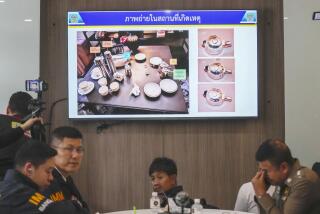Pulling a fast one with killer lip gloss
- Share via
“CSI: Miami,” CBS, Oct. 9.
The premise: The co-owners of a modeling agency are under investigation for allegedly plotting the murders of their models to collect on an insurance policy. As the suspicion against them grows, they turn on each other. One is shot in the chest, but not before she spikes the other’s lip gloss with cyanide. A few minutes after applying the lip gloss, its wearer begins to cough, has difficulty breathing and dies.
The medical questions: Is it possible to spike lip gloss with a sufficient amount of undetectable cyanide to kill? Are coughing and rapid suffocation an accurate portrayal of cyanide poisoning? Although the investigators watch her die, could medical intervention keep a victim going until help arrives? Is there an antidote to the poison?
The reality: Although cyanide can be added to cosmetics, or food, in a potentially lethal amount, the concentration required (more than 500 milligrams per gram) would probably cause an almond taste and a burning sensation when licked. Further, victims would be unlikely to absorb or ingest enough to die as quickly as the show depicts.
In general, victims of a large cyanide exposure -- more than 200 milligrams of the crystal or 50 milligrams of hydrocyanic acid (the liquid form) -- may feel anxious, nauseated, have a headache, feel short of breath and cough, then gasp for air, have convulsions and heart arrhythmias, lose consciousness and die -- all within an hour after ingestion. They also may appear flushed and have a bitter almond smell on their breath.
Victims suffocate from respiratory depression or sustain lethal heart arrhythmias as the cyanide interferes with hemoglobin metabolism (depriving the body’s tissues of oxygen). The initial treatment is to administer pure oxygen. Common cyanide antidotes are nitrites and sodium thiosulfate, which work together to restore the hemoglobin. These aren’t often completely effective, however, in part because the cyanide may have already done a lot of damage by the time the antidotes are administered.
Notably, the CSI investigators don’t initiate cardio-pulmonary resuscitation or call 911. The former may be partly understandable -- the would-be rescuer can be poisoned by the lips of the victim. But calling 911 wouldn’t have necessarily been a wasted effort. Though it is true that CPR, gastrointestinal decontamination (induced vomiting, gastric lavage to wash out the stomach and activated charcoal to absorb the poison) and even oxygen are not completely effective, all of these measures could have bought some time for paramedics or medical professionals to administer a cyanide antidote.
Dr. Marc Siegel is an internist and an associate professor of medicine at New York University’s School of Medicine. He is also the author of “False Alarm: The Truth About the Epidemic of Fear.” In The Unreal World, he explains the medical facts behind the media fiction. He can be reached at marc@doctorsiegel.com.






